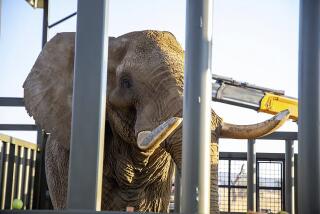Elephants were the heavy favorite in a short-lived sport
Just how an Elephant Racing Club materialized at Orange County State College, now Cal State Fullerton, in 1962 is a matter of debate.
One story credits a whimsical bureaucrat who drew up the application for forming clubs on campus. Next to the space marked “Name,” he wrote “Elephant Racing Club” as a hypothetical example.
Another version credits the dean of students, who had taught in India.
He supposedly joked about a pachyderm competition when students were searching around for a spring-madness-type exercise.
Whatever the explanation, the Elephant Racing Club was formed, and challenges for a competition were sent to several schools.
Some cynics recall that the theory was that no one would respond, enabling Orange County State to declare itself the winner.
But the Coast Guard Academy signed up, mentioning that it had an elephant donated by Ceylon, now called Sri Lanka, for some good deed.
After several days of negotiations, though, the academy admitted that the elephant was nonexistent. The school’s football coach commented, “I’ve got some guys who move like elephants,” but he didn’t want to enter any of them in the race.
The publicity, however, prompted more than a dozen other colleges, including Harvard, to agree to Orange County State’s earthshaking idea.
All of a sudden, it was a reality -- the First Intercollegiate Elephant Race in Human History, as organizers called it. Others dubbed it, less grandly, the Run for the Peanuts.
The funny thing was: No one had an elephant. But that was no problem.
A theme park called Jungleland in Thousand Oaks did, and agreed to rent several elephants for any needy team, along with handlers. A few out-of-state entrants managed to scare up some beasts from local circuses.
A cornfield on Orange County State’s still-rural campus was chosen for the race.
“It was perfect,” recalled Jack Hale, a student organizer. “The farmer who used it had already picked the corn.”
On the May 11 racing day, colorful banners hung from the temporary stands.
“College bands pumped out a stream of elephant music to regale the spectators and mollify the elephants,” wrote Jack Smith, The Times’ man on the spot.
A telegram was received from former Vice President Richard Nixon, who advised officials to use an official Amateur Athletic Union “wind-measuring machine at the race course. An aiding wind greater than 4.77 mph will render your times unofficial and unacceptable at the world level,” he joked.
A scandal was exposed when it was discovered that Santa Ana College’s entry, Rudy, “turned out to be two Santa Ana students in an elephant suit,” Smith wrote. “The subterfuge was discovered when the zoologist tried to take its temperature.”
Cal Lutheran’s entrant, meanwhile, looked more like a turtle than an elephant, the judges noticed.
Their suspicions were “confirmed by Orange County State’s professor of zoology,” Smith wrote.
Cal Lutheran admitted that Torty was a 550-pound elephant turtle but characterized it as an “early model elephant.”
Torty was not only allowed to compete, but was also given a 96.2-yard head start in the 100-yard race. After all, Torty deserved some respect since its age was estimated to be 150.
Several races were held so there would be no herds of more than four elephants thundering across campus at one time.
The winners included Kinney II, Long Beach State’s 4-ton pachyderm, who “loped 50 yards past the finish line, scattered a bank of spectators and thundered home to the compound,” where a dinner of hay awaited, Smith wrote.
James Kott, Kinney’s dashing rider, stayed aboard the animal all the way, revealing, “I dug my feet in his side and held on to his ears.”
Torty came in last despite its head start.
The extravaganza was deemed such a success that it was staged again the next year at the Los Alamitos Race Course. Because women were allowed as riders, it was retitled the Second Annual (and First Coeducational) Intercollegiate Elephant Race. Others clung to the Run for the Peanuts.
Particular attention was paid to Bonnie Lynne Volk of Sarah Lawrence College, whose stretch pants burst mid-race, forcing her to appropriate some of her creature’s colors.
Despite the success of the shows, the sport of elephant racing never caught on.
The only exotic animals who currently race at Los Alamitos are dachshunds -- and that’s for just one day a year.
Looking back, Hale suspects that his school grew understandably nervous about the dangers of elephants and decided not to stretch its luck with any more races.
“Can you imagine the courage of the administration to let us kids pull this thing off back then?” said Hale, who rode a mount named Sheba without incident.
The year 2012 will mark the 50th anniversary of the First Intercollegiate Elephant Race in Human History.
If a reunion is held, as expected, perhaps one of the original beasts could attend. After all, Torty would be only about 200 years old now.
--


